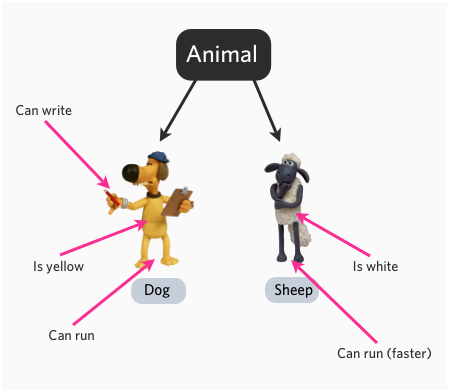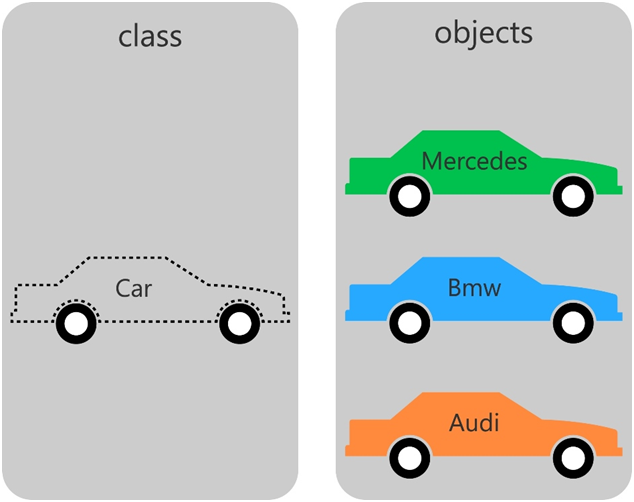PHP object-oriented
PHP Object-oriented
In object-oriented programming (English: Object-oriented programming, abbreviation: OOP), an object is a whole composed of information and a description of how to process the information. An abstraction of the real world.
In the real world, the things we face are objects, such as computers, televisions, bicycles, etc.
The main three characteristics of objects:
· Object behavior: What operations can be applied to the object, turning on the light and turning off the light are behaviors.
· Object Form: When those methods are applied to how the object responds, color, size, appearance.
· Representation of objects: The representation of objects is equivalent to an ID card. It specifically distinguishes the differences between the same behaviors and states.
For example, Animal is an abstract class. We can be specific to a dog and a sheep, and dogs and sheep are concrete objects. They have color attributes, can be written, can run and other behavioral states. .

#Object-oriented content
· Overloading − Simply put, it is a situation where functions or methods have the same name but different parameter lists. Such functions or methods with the same name and different parameters are called overloaded functions or methods.
· . A class is an abstraction that reflects important properties related to an application while ignoring other irrelevant content. The division of any class is subjective, but must be related to the specific application.
· Encapsulation − Encapsulation refers to binding together the properties and behavior of an object that exists in the real world and placing it within a logical unit.
· Constructor − It is mainly used to initialize the object when creating the object, that is, assign initial values to the object member variables. It is always used together with the new operator in the statement to create the object.
· − Destructor (destructor) Contrary to the constructor, when the object ends its life cycle (for example, the function in which the object is located has been called), the system automatically executes the destructor. Destructors are often used to do "clean-up" work (for example, when creating an object, use new to open up a memory space, which should be released with delete in the destructor before exiting).
In the figure below, we have created three objects through the Car class: Mercedes, Bmw, and Audi.
$mercedes = new Car (); $bmw = new Car (); $audi = new Car ();

##PHP Class Definition
PHP The usual syntax format for defining a class is as follows: The analysis is as follows: · Classes are defined using the class keyword followed by the class name. · Variables and methods can be defined within a pair of curly brackets ({}) after the class name. · Class variables are declared using var, and variables can also be initialized. · Function definition is similar to the definition of PHP function, but the function can only be accessed through the class and its instantiated objects. Instanceurl = $par; } function getUrl(){ echo $this->url . PHP_EOL; } function setTitle($par){ $this->title = $par; } function getTitle(){ echo $this->title . PHP_EOL; } } ?>
Variable $this represents its own object.
PHP_EOL is the newline character.
Create objects in PHP
Call member methods
After instantiating an object, we can use the object to call member methods. The member methods of the object can only operate on the object. Member variables:
// Call the member function and set the title and URL
$runoob->setTitle( "PHP Chinese Network" );
$taobao-> setTitle( "Taobao" );
$google->setTitle( "Google Search" );
$runoob->setUrl( 'www.ask. php.cn' );
$taobao->setUrl( 'www.taobao.com' );
$google->setUrl( 'www.google.com' );
// Call the member function to get the title and URL
$runoob->getTitle();
$taobao->getTitle( );
$google->getTitle();
$runoob->getUrl();
$taobao->getUrl ();
$google->getUrl();
The complete code is as follows:
Example
url = $par; } function getUrl(){ echo $this->url . PHP_EOL; } function setTitle($par){ $this->title = $par; } function getTitle(){ echo $this->title . PHP_EOL; } } $runoob = new Site; $taobao = new Site; $google = new Site; // 调用成员函数,设置标题和URL $runoob->setTitle( " PHP中文网" ); $taobao->setTitle( "淘宝" ); $google->setTitle( "Google 搜索" ); $runoob->setUrl( 'www. ask.php.cn ' ); $taobao->setUrl( 'www.taobao.com' ); $google->setUrl( 'www.google.com' ); // 调用成员函数,获取标题和URL $runoob->getTitle(); $taobao->getTitle(); $google->getTitle(); $runoob->getUrl(); $taobao->getUrl(); $google->getUrl(); ?>
Execute the above code, the output result is:
PHP Chinese website
Taobao
Google search
www.ask.php.cn
www.taobao.com
www.google.com
##PHP Constructor
$runoob = new Site('www.runoob.com', 'PHP中文网'); $taobao = new Site('www.taobao.com', '淘宝'); $google = new Site('www.google.com', 'Google 搜索'); // 调用成员函数,获取标题和URL $runoob->getTitle(); $taobao->getTitle(); $google->getTitle(); $runoob->getUrl(); $taobao->getUrl(); $google->getUrl();
#Destructor
Destructor (destructor) Contrary to the constructor, when the object ends its life cycle (for example, the function in which the object is located has been called), the system automatically executes the destructor.
PHP 5 introduced the concept of destructor, which is similar to other object-oriented languages. Its syntax format is as follows:
void __destruct (void)
Example
name = "MyDestructableClass"; } function __destruct() { print "销毁 " . $this->name . "\n"; } } $obj = new MyDestructableClass(); ?>
Execute the above code, the output result is:
Constructor
Destroy MyDestructableClass
Inheritance
PHP uses the keyword extends to inherit a class. PHP does not support multiple inheritance. The format is as follows:
class Child extends Parent {
// Code part
}
Instance
The Child_Site class in the instance inherits the Site class and extends the functionality:
// Child class extends site category
class Child_Site extends Site {
var $category;
Function Setcate ($ Par) {
$ This-& GT; Category = $ Par;
##}# Echo $ This- & GT; Category. PHP_EOL;
##}##}
## This
#Method rewriting
If the method inherited from the parent class cannot meet the needs of the subclass, it can be rewritten , this process is called method override, also called method rewriting.The getUrl and getTitle methods are rewritten in the example:
PHP access control to properties or methods is achieved by adding the keywords public (public), protected (protected) or private (private) in front.· PUBLIC (Public): Public members can be accessed anywhere.
# · Protected: The protected members can be accessed by them and their subclasses and parent class.
· Prive (private): Private class members can only be accessed by their class.
Access control of attributesClass attributes must be defined as one of public, protected, and private. If defined with var, it is considered public.
public; echo $this->protected; echo $this->private; } } $obj = new MyClass(); echo $obj->public; // 这行能被正常执行 echo $obj->protected; // 这行会产生一个致命错误 echo $obj->private; // 这行也会产生一个致命错误 $obj->printHello(); // 输出 Public、Protected 和 Private /** * Define MyClass2 */ class MyClass2 extends MyClass { // 可以对 public 和 protected 进行重定义,但 private 而不能 protected $protected = 'Protected2'; function printHello() { echo $this->public; echo $this->protected; echo $this->private; } } $obj2 = new MyClass2(); echo $obj2->public; // 这行能被正常执行 echo $obj2->private; // 未定义 private echo $obj2->protected; // 这行会产生一个致命错误 $obj2->printHello(); // 输出 Public、Protected2 和 Undefined ?>
Method access control
Methods in a class can be defined as public, private or protected. If these keywords are not set, the method defaults to public.
MyPublic(); $this->MyProtected(); $this->MyPrivate(); } } $myclass = new MyClass; $myclass->MyPublic(); // 这行能被正常执行 $myclass->MyProtected(); // 这行会产生一个致命错误 $myclass->MyPrivate(); // 这行会产生一个致命错误 $myclass->Foo(); // 公有,受保护,私有都可以执行 /** * Define MyClass2 */ class MyClass2 extends MyClass { // 此方法为公有 function Foo2() { $this->MyPublic(); $this->MyProtected(); $this->MyPrivate(); // 这行会产生一个致命错误 } } $myclass2 = new MyClass2; $myclass2->MyPublic(); // 这行能被正常执行 $myclass2->Foo2(); // 公有的和受保护的都可执行,但私有的不行 class Bar { public function test() { $this->testPrivate(); $this->testPublic(); } public function testPublic() { echo "Bar::testPublic\n"; } private function testPrivate() { echo "Bar::testPrivate\n"; } } class Foo extends Bar { public function testPublic() { echo "Foo::testPublic\n"; } private function testPrivate() { echo "Foo::testPrivate\n"; } } $myFoo = new foo(); $myFoo->test(); // Bar::testPrivate // Foo::testPublic ?>
Interface
Using interface (interface), you can specify which methods a class must implement, but not The specifics of these methods need to be defined.The interface is defined through the interface keyword, just like defining a standard class, but all methods defined in it are empty.All methods defined in the interface must be public. This is a characteristic of the interface.
To implement an interface, use the implements operator. The class must implement all methods defined in the interface, otherwise a fatal error will be reported. A class can implement multiple interfaces. Use commas to separate the names of multiple interfaces.
vars[$name] = $var; } public function getHtml($template) { foreach($this->vars as $name => $value) { $template = str_replace('{' . $name . '}', $value, $template); } return $template; } } ?>
Constant
You can define a value that always remains unchanged in the class as a constant. There is no need to use the $ symbol when defining and using constants.
The value of a constant must be a fixed value and cannot be a variable, class attribute, the result of a mathematical operation or a function call.
Since PHP 5.3.0, you can use a variable to dynamically call a class. But the value of this variable cannot be a keyword (such as self, parent or static).
Instance
showConstant(); echo $class::constant . PHP_EOL; // 自 PHP 5.3.0 起 ?>
Abstract class
Any class, if there is at least one in it If the method is declared abstract, then the class must be declared abstract.
Classes defined as abstract cannot be instantiated.
A method defined as abstract only declares its calling method (parameters) and cannot define its specific function implementation.
When inheriting an abstract class, the subclass must define all abstract methods in the parent class; in addition, the access control of these methods must be the same (or more relaxed) as in the parent class. For example, if an abstract method is declared as protected, then the method implemented in the subclass should be declared as protected or public, and cannot be defined as private. In addition, the method calling methods must match, that is, the type and number of required parameters must be consistent. For example, if a subclass defines an optional parameter that is not included in the declaration of an abstract method of the parent class, there is no conflict between the two declarations.
getValue() . PHP_EOL; } } class ConcreteClass1 extends AbstractClass { protected function getValue() { return "ConcreteClass1"; } public function prefixValue($prefix) { return "{$prefix}ConcreteClass1"; } } class ConcreteClass2 extends AbstractClass { public function getValue() { return "ConcreteClass2"; } public function prefixValue($prefix) { return "{$prefix}ConcreteClass2"; } } $class1 = new ConcreteClass1; $class1->printOut(); echo $class1->prefixValue('FOO_') . PHP_EOL; $class2 = new ConcreteClass2; $class2->printOut(); echo $class2->prefixValue('FOO_') . PHP_EOL; ?>
Execute the above code, the output result is:
ConcreteClass1
FOO_ConcreteClass1
ConcreteClass2
FOO_ConcreteClass2
Static keyword
Declaring a class attribute or method as static allows direct access without instantiating the class.
Static properties cannot be accessed through an object of a class that has been instantiated (but static methods can).
Since static methods do not require an object to be called, the pseudo variable $this is not available in static methods.
Static properties cannot be accessed by objects through the -> operator.
Since PHP 5.3.0, you can use a variable to dynamically call a class. But the value of this variable cannot be the keywords self, parent or static.
staticValue() . PHP_EOL; ?>
Execute the above program, the output result is:
foo
foo
Final keyword
PHP 5 adds a new final keyword. If a method in the parent class is declared final, the child class cannot override the method. If a class is declared final, it cannot be inherited.
An error will be reported when executing the following code:
Call the parent class constructor
PHP No The constructor of the parent class will be automatically called in the constructor of the subclass. To execute the parent class's constructor, you need to call parent::__construct() in the child class's constructor.
Execute the above program, the output result is:
Construction method in BaseClass class
Construction method in BaseClass class
Construction method in SubClass class
Construction method in BaseClass class

![Front-end Vue3 actual combat [handwritten vue project]](https://img.php.cn/upload/course/000/000/068/639b12e98e0b5441.png)
![APIPOST tutorial [Popularization of technical concepts related to network communication]](https://img.php.cn/upload/course/000/000/068/63996f34c6c94370.png)










